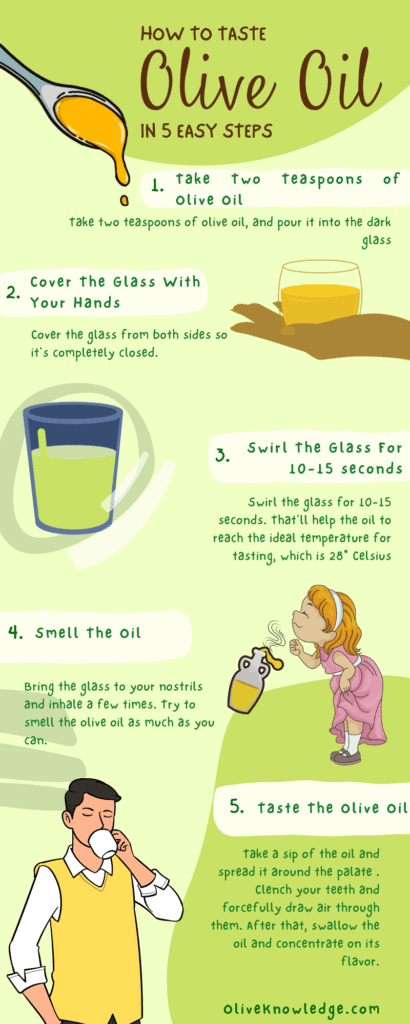How To Taste Olive Oil: Easy Guide For Beginners
Olive Knowledge is a part of Amazon Associates. As an Amazon Associate, we earn from qualifying purchases. Read our Affiliate Disclosure to learn more.
When you know the proper way of tasting olive oil, you’ll be able to spot whether olive oil is high quality or the oil is some low-quality product.
I’ll teach you the exact steps I follow when tasting olive oil so you can do the same, just like a real olive oil sommelier.
Key Takeaways:
- Pour olive oil into a glass, warm it with your hands, smell it, then taste it.
- Judge olive oil by flavor, not color; color varies with olive ripeness and compounds.
- Smell for aromas like herbs, fruits, or almonds; unpleasant smells indicate low quality.
- Taste should be clean and vibrant; bitterness and pepperiness indicate high quality.
- Avoid tasting on an empty stomach, compare several oils, and pair them with food for the best experience.
How To Taste Olive Oil: The Guide

There are a few steps to taste extra virgin olive oil properly. Pay attention to each, and just follow them when tasting olive oil. Also, try not to eat anything 20-30 minutes before tasting olive oil. If you ate something, take a slice of bread or a few bites of green apples to neutralize the receptors in your mouth.
What you’ll need:
- Small dark-colored glass (preferably blue)
5 Steps You Should Take To Taste The Olive Oil:
- Take two teaspoons of extra virgin olive oil and pour it into the glass
- Put one hand below the glass and another above to keep it closed
- Keep it covered while swirling with your hands to warm up the olive oil quicker to around 28°Celsius (82°F). You can’t know the exact temperature, but try to do this for around 10-15 seconds. After that, swirl the glass a few more times, and it’s ready.
- Smell the olive oil: Bring the glass to your nostrils and inhale a few times. Try to smell the olive oil as much as you can.
- Taste the olive oil: Take a sip of the oil and spread it around the palate with your tongue in order to have the best possible conditions for analyzing the taste. Then, clench your teeth and forcefully draw air through them. After that, swallow the oil and concentrate on its flavor.
Okay, these were quick steps of how the tasting is done. Now, let’s see the things you need to pay attention to.
Color
Olive must be judged by its flavor, not color! Professional judges always use a blue-tinted glass when tasting olive oil. That way, they can concentrate on the smell and taste, not the color of olive oil.
Many people think that the color of olive oil shows its quality. However, it’s a complete myth, and it’s far away from the truth. The color of olive oil is an indication of how ripe olives were at the time of the harvest and also the amount of chlorophyll and carotenoids.
Chlorophylls add a green color to olive oil, while carotenoids add a golden color to the oil. Usually, oil made from early-harvested olives will have a more greenish color, and oil made from late-harvested olives will have a more yellowish or golden color.
However, if olive oil looks completely transparent or completely dark, it’s a large indication of low-quality olive oil.
Smell
When smelling olive oil, try to keep the glass as close to your nostrils as possible. That way, you’ll be able to collect all the aromas from the oil.
As a beginner, it might be hard for you to determine all the aromas in the oil. However, here are the ones you should smell, depending on the time of the harvest:
- Early Harvest Olive Oil Smell: it should be very aromatic. You should smell the grass, olives, freshly cut herbs, flowers, mint, and almonds
- Late Harvest Olive Oil Smell: lighter smell, sweet tones of banana and almonds
I have to mention that different olive cultivars may have different aromas. Some cultivars will smell like fruit, tomatoes, nuts, ricola, and similar. All in all, the smell should be pleasurable.
For instance, I like the smell of quality olive oils so much that I could breathe it the whole day. That’s the feeling you should get!
If you can’t smell any aromas, or you smell crayons, stale peanuts, vinegar, etc. It’s a sign of low-quality olive oil, which will be confirmed by tasting the oil.
Taste
The taste is the king of olive oil quality determination. It’s the final step, and after tasting extra virgin olive oils, you’ll know if it’s good or not.
Here’s what you should taste:
- Early Harvest Olive Oil Taste: vibrant and structured bitterness, delayed pungent in the throat, pepperiness
- Late Harvest Olive Oil Taste: lighter, sweet, bitter in the beginning, reminds of almonds
All in all, the taste should be clean, vibrant, and peppery. If you cough, that’s fine! Actually, that’s a sign that there are plenty of antioxidants in the oil, which is wanted. Also, once you taste the olive oil, it’ll stay in your mouth for 5+ minutes, so try to acquire as many flavors as you can.
If the flavor is very greasy, musty, rancid, metallic, vinegary, winey, or anything similar that’s not pleasurable, it’s a sign of bad olive oil. Actually, it is a bad olive oil if you experience any of these flavors.
I made a quick table you can follow when tasting olive oil. It’ll help you with aromas and flavors. Make sure to check it out here.
Additional Tips From Professional Olive Oil Tasters
I won’t go long here, but here are a few additional tips from professional olive oil tasters and oleologists:
- Don’t taste olive oils on an empty stomach, but make sure not to eat 20-30 minutes before tasting
- When tasting olive oil, taste 3 to 5 different olive oils. That way you’ll be able to choose which one fits you the best.
- When tasting more olive oils, between each oil, take a slice of bread or a few slices of green apples. They’ll help you to delete the flavors so that you can test another olive oil.
- Know the cultivar. It’s important to know the olive variety prior to tasting the oil. That way, you can know what it should smell and taste like. A quick google search may help you with that.
- Taste olive oil together with some food. Many people like to try it in combination with truffles, sea fish, bread, salads, etc. Mostly, it’ll go well with Mediterranean types of food.
Here’s a quick infographic I made so you can share it easily on social media 🙂

So, that’s all you should know to properly start tasting olive oil. With time, you’ll get more knowledge, and you’ll know what to expect from high-quality olive oils, especially when we talk about extra virgin olive oils, which are the most popular type of olive oil.
When you learn more, I suggest becoming an olive sommelier since that’s extremely trendy nowadays, and you’ll have the opportunity to attend some of the best olive oil competitions.
